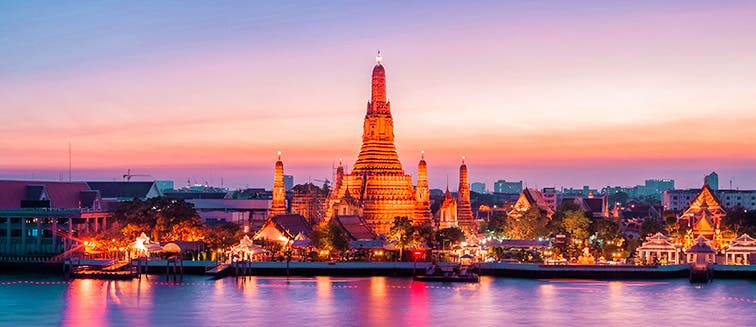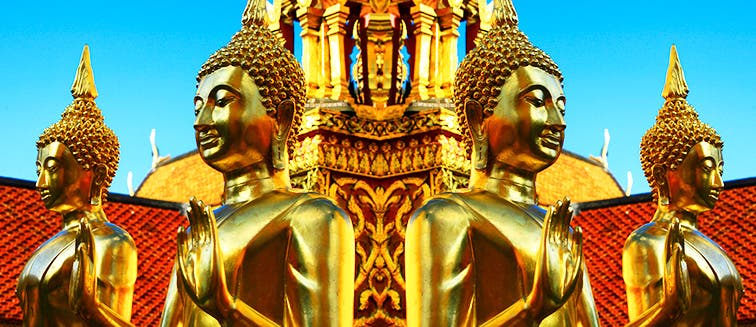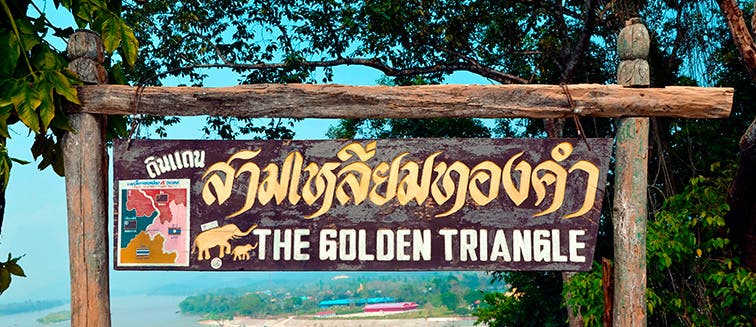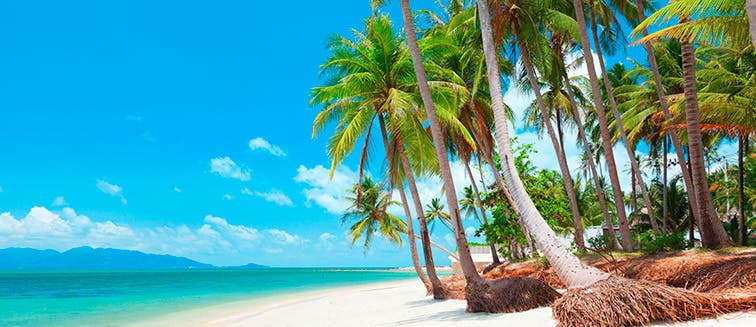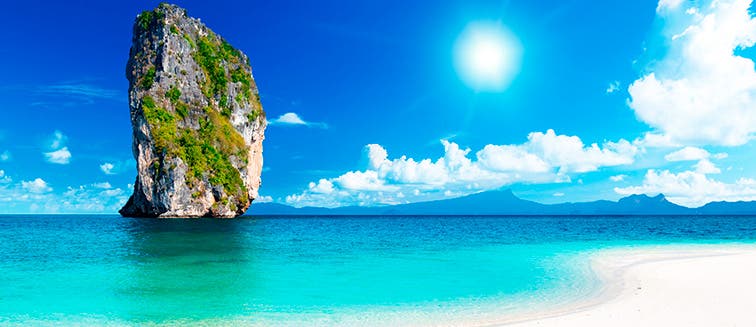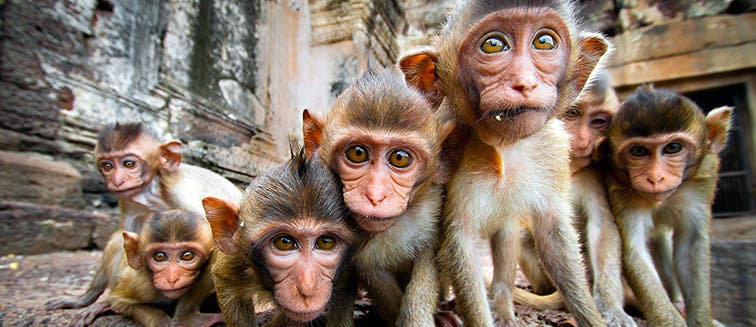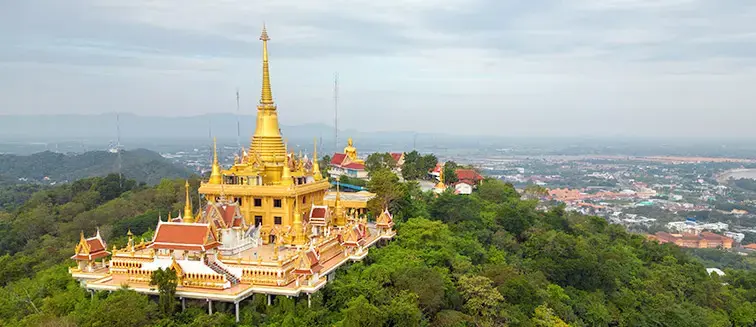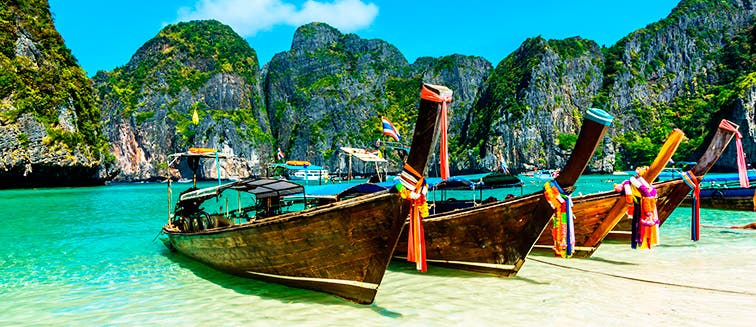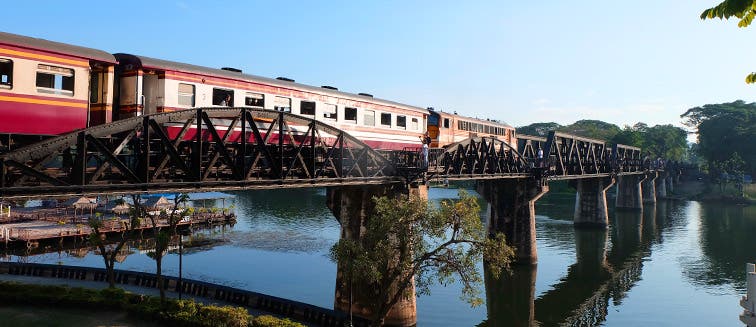Africa
Americas
Asia
Europe
Oceania
Travel Agent Support:
+61 02 8823 5094
Mon - Fri: 9 am - 15 hrs
Saturday & Sunday: Closed
What to see in Thailand
Bangkok
Tourist attractions Bangkok
The 169 letters that form the full Thai name of the city of Bangkok is the longest city name in the world. Its short translation is “The city of angels, the great city, the residence of the Emerald Buddha, the impregnable city of God Indra, the grand capital of the world endowed with nine precious gems, the happy city, abounding in an enormous Royal Palace that resembles the heavenly abode where reigns the reincarnated god, a city given by Indra and built by Vishnukarn.” With a name like this, a tour of Bangkok is an unmissable experience when visiting Thailand.
Gateway to Southeast Asia, it is the political, social and economic center of Thailand and of all Indochina. Located in the south of the country, it lies on the banks of the famous Chao Phraya River that is subdivided into a dense network of serpentine waterways or klongs, which has given rise to the nickname of "Venice of the North". Its tropical monsoon climate makes it warm and humid. It is divided into 50 districts of which 35 are east of the river and the remainder to the west.
Travelling to Bangkok means discovering a place of contrasts, a mixture between East and West, between the traditional and the modern, between the past and the future. It is a opposite without order or agreement; temples and skyscrapers, tuk-tuks and aerial metro, lanterns and neon signs, markets and luxury shopping centers, humble food stalls and great restaurants, the smell of smoky cooking and incense, poor and rich, locals and foreigners, chaos and meditation, the eternal noise of car horns and spiritual silence...
The frenetic pace marked by its 9 million inhabitants, the high temperatures, the intense traffic, and the pollution together with the colour of its exciting architecture, the deep religious fervor and the kind character of its people, present a city full of life.
The Lumpini Park, in the heart of the business district, is a green oasis in the middle of an asphalt jungle and an ideal place to practice outdoor sports. People of all ages make use of the gym with weights and equipment or the jogging track and attend classes such as aerobics, yoga, dancing or tai chi at sunset. It is also a good refuge to relax from the unbridled speed of the city and stroll or navigate the artificial lake. Everyone is paralysed in a sign of respect when the country's anthem sounds through the speakers for 40 seconds, then continue going about their activities. It is curious to see how giant monitor lizards, relatives of the Komodo Dragon, roam freely through the park, although there is nothing to fear because it is a non-aggressive species.
The treasure of Bangkok is called Phra Borom Maha Ratchawang or Great Palace, which was built when the city received the status of capital. King Rama I displaced the Chinese community settled on the pseudo-island of Rattanakosin, formed by the Chao Phraya River and several excavated canals, to erect this architectural wonder in the year 1782. It continued to expand throughout the following century and was the Royal Court, the Administrative Headquarters of the Government and the royal residence of the following generations of the Chakri dynasty until 1925. Today its use is limited to religious celebrations and official events.
The Grand Palace of Bangkok is a rectangular walled complex of 218,400 square meters that houses several buildings, all facing north, such as temples, chapels, chedis, halls, open pavilions, patios and gardens. For its construction, many materials were used that were dismantled from the temples of Ayutthaya by order of the king when it ceased to be the capital and was destroyed by the Burmese.
Most of the buildings are faithful to classical Thai architecture, although in their design you can appreciate the different artistic currents and the influences of neighbouring countries, the fruit of the evolution of the passing of the years. In their overwhelming artistic repertoire there is extraordinary decoration in the pointy gabled roofs and in the columns, the facades and the pavements, exhibiting a masterful work in the realization of the paintings and sculptures mythological, in the carving of wood and stone, in the application of stucco and lacquer, in the use of metals and in the composition mosaics of glass, tiles and ceramics.
As soon as you cross the entrance, you access the outer patio of the complex. It is a garden area with buildings and civil pavilions such as the Museum of Royal Clothing and the Museum of Coins & Medals. This place is the prelude to the most important and impressive area of the complex where the temples are found.
The Golden Stupa of the Temple of Phra Sri Rattana Chedi is the first thing that catches the attention as light is reflected from the golden facade. Inside, the temple houses relics and statues and behind it there is a model of the Angkor Wat Temples of Cambodia. Two imposing Thotkhirithon of 5 meters high guard the entrance to the temple and the beautiful sculptures of kinnari, a half woman, half bird creature, grant grace and elegance.
The building of the Royal Pantheon or Prasat Phra Thep Bidon is impressive. It has a tiled roof of red, white and green tones which contrast with the splendid gold of the magnificent main door.
Beside it stands the Temple of the Emerald Buddha or Wat Phra Kaew, the most famous and revered in the country. It is a royal chapel that, together with its pagodas, is surrounded by a white wall on which an epic poem is engraved. The facades are a true work of art, they are completely filled with millions of crystals and precious stones and around them, there is a string of sculptures of garuda, half man and half bird creatures, a symbol of royalty and supremacy. All the details are sublime. Inside, the iconic Emerald Buddha rests on a golden altar. Considered the symbol of Thailand, supernatural powers are attributed to him and he wears three different garments a year depending on whether the season is hot, cold or rainy. Despite its name, the sculpture was carved from jade in the 15th century and measures only 45 cm in height. Since its creation in India it has travelled from the Angkor Wat in Cambodia to Ayutthaya in Chiang Rai and Thonburi before reaching the Grand Palace. It is forbidden to take photographs inside.
Once you leave behind this area you can access the central courtyard where the curious and peculiar Chakri Maha Prasat Hall building, with Renaissance facades and Thai roofs. The reason for this mixture is the admiration of Rama V for the European aesthetic, a result of his travels through the old continent. He entrusted the project to an English architect. It was the residence of the king and currently houses a museum of royal weapons on the right side and the rest of the rooms are used for official receptions.
In the Siwalai Garden, the Court is separated from the royal halls and there are religious and residential buildings besides the park itself.
The Grand Palace in Bangkok is the paradigm of Thai architecture. It is an example of great beauty, a pleasure for the eyes, and a display of the dazzling, embossed, elegant and unique decoration of the country.
Nearby is the Wat Phra Chetuphon Wimon Mangkalaram or Wat Pho, the oldest temple in the city. It was built in the seventeenth century in the days of Rama I and remodeled in successive reigns. In the chapel of Phra Vihara lies the Reclining Buddha, the largest in Thailand, measuring 46 m long and 15 m high, covered with gold leaf and sat on a pedestal where they say lie the ashes of the king. His position represents the transition from death to Nirvana.
This colossal statue is literally squeezed between the ceiling and the huge lacquered wooden columns that delimit the entrance and exit corridors that surround the image and through which the faithful and tourists parade, respecting the rituals by depositig alms in the 108 bronze vessels lined up in search of good luck. Its walls and pilasters are beautifully painted with mystical motifs.
Particular detail is the eyes and the soles of the feet, which have been meticulously engraved with inlaid mother-pearl, being able to distinguish fingerprints and 108 signs, omens, teachings and other religious symbols.
The walled enclosure of Wat Pho is 80000 square meters, with 16 doors guarded by statues of Chinese granite warriors, more than 1000 of which came from the abandoned temples of Ayutthaya and Sukhothai.
In the northern part of the complex is the sacred area, where in addition to the Phra Vihara is the main prayer hall Phra Ubosot which houses the Phra Buddha Deva Patimakorn, placed on a three-level basement in meditation position and wearing a parasol.
In the southern part is the residential monastery area with a large library; 91 chedis covered with white mortar and in lays of colourful tiles, shells and Chinese porcelain, among which stands out the Phra Maha Chedi Si Rajakarn, a group of 4 stupas of 42 m high dedicated to the four first kings of the dynasty Chakri; the Misakawan gardens; a patio with a bhodi tree of lighting; a fountain; the School of Traditional Thai Medicine and the School of Massage.
Right on the opposite bank of Chao Phraya stands the Wat Arun, who honors the Hindu god Aruná, the personification of the dawn.
In the seventeenth century, at the time of the Kingdom of Ayutthaya, it was called Wat Makok. When the city fell into the hands of the Burmese, King Taksin transferred the capital to Thonburi and called it Wat Chaeng or Temple of Dawn, as the locals know it today. In the following years Rama II restored and expanded it but it was Rama IV who finally baptised it as Wat Arun Ratcha Wararam, another of the endless Thai names.
A symbol of the city, it housed the Emerald Buddha until it was transferred to the Grand Palace.
Its stupa of Khmer style is 82 m high and represents Mount Meru, sacred abode of Lord Shiva. Crowned with a trident of 7 points, in the high part it presents some niches with figures of the god Indra on the back of the three-headed elephant Erawan and around its base there are stone sculptures of Chinese animals and soldiers. A narrow and steep staircase leads to the terraces from where you can see one of the most fascinating panoramas of the city. The other 4 towers, located in the corners, are dedicated to the god of the wind and exhibit images of the moon god on a white horse.
They are built in brick covered with stucco and decorated with inlaid enameled china and coloured crystals, fine and beautiful ornamentation that allows the whole temple to radiate luminosity when the star is reflected in it.
Some impressive guardian demons are on either side of the entrance door, which gives access to small gardens, chedis and several buildings such as the ordination hall that houses an image of Buddha.
The attraction of this important place of Buddhist worship lies in its unique design, different from that of the other temples.
Although its name refers to the dawn, the truth is that it is at sunset when it can be admired in its greatest splendor, as the last rays of the sun give it a beautiful shine and at nightfall it is illuminated majestically reflecting on the waters of the River of the Kings and projecting one of the most photographed, mystical, and unforgettable images of the capital.
The Wat Benchamabophit or Marble Temple, from the end of the 19th century, was built in white marble imported from the Italian city of Carrara. With clear European influences on its immaculate facade and striking red roofs, this temple is considered one of the most beautiful in the city for its neat aesthetic that gives it a romantic feel. The ashes of King Rama V rest on the throne of the Buddha Phra Budhaji Naranja, which is displayed in the ordination hall in front of a vibrant blue background and in the courtyard gallery there are 52 bronze figures representing Buddha.
Bangkok’s Chinatown is the largest in the world and a vibrant place to visit. It began to form when Rama I displaced the Chinese emigrants a little beyond their former location in order to construct the Grand Palace, moving the capital from Thonburi to the other side of the river. This part of Bangkok preserves its millenarian culture and Chinese traditions through its colourful architecture, its unique cuisine and its curious rituals.
In the Odeon Square is the great Chinese ceremonial gate. Yaowarat Road begins here, which along with Charoen Krung are the most important of the neighborhood and that along with the rest of the streets or alleys, during the day they turn into a hotbed of cars, taxis, garlands, motorcycles, tuk-tuks, stalls street vendors, vegetable stalls and exotic fruits that occupy the sidewalks, red lanterns, locals, tourists, smell of incense and gifts for the dead.
When day fades into night, the luminous signs are lit and the neighbourhood shows its most charming side whilst market people fill the stalls with fresh food and restaurants open to share a rich array of Asian food with hungry customers.
In the heart of Chinatown is the Temple of the Golden Buddha or Wat Traimit, the third most important in the city. It houses the largest solid gold figure in the world, weighing 5,500 kg. It was covered in plaster and decorated with colours to prevent it from being stolen by the Burmese, and it was not until later when restoration work began that its contents were revealed by surprise. In the Sanchao Dtai Hong Kong Temple you can witness celestial bank transfers to the dead or devotees buying real money imitations only to burn it in a hope it will reach their deceased relatives. The Dragon Lotus Temple is the most important and largest Buddhist Chinese temple in the city, where the Chinese New Year festival is celebrated.
The well-known Khao San Road is where backpackers and tourists spend the summers enjoying the different services at inflated prices. Filled with luminous advertisements, pubs, bars, restaurants, grilled food stalls, entertainment halls, supermarkets, brothels, massage parlors and street vendors, it is the busiest street in the capital.
Between Chinatown and Chao Phraya lives the Indian community in Little India. The main street is Phahurat Road and the most important monument is the Sikh Sri Guru Singh Sabha Temple. This beautiful white 6-story building, with a slender golden dome, was built in 1932 and is the second largest outside of India. In the neighborhood there are many restaurants, shops selling silk fabrics and tailor-made garments, electronics, spices and food products.
The markets are a constant in Bangkok and it is inevitable to run into any of them. There are dozens of all kinds; daily, weekly, nocturnal or improvised. The practice of bargaining is common in order to get a good price. Among the best known are the daily Sampeng market in Yaowarat, mainly wholesale; the Pratunam covered market, famed for its textile products; the Chatuchak weekend market, which has more than 8,000 stalls of all kinds of products, is the largest in the country and one of the largest in the world; Wang Lang's daily market, opposite the Grand Palace; the night market of Saphan Phut, purely local; the Pak Khlong market, selling flowers wholesale and open 24 hours a day, where vivid colours and intoxicating aromas seduce the visitor; the Patpong night market located in Silom, famous for its counterfeits; the Tor Kor market, with excellent fresh selected food and the train market, which although located in the village of Mae Klong, 90 km from Bangkok, deserves a special mention for its originality. The food stalls cover the train track and when the train approaches with a horn, vendors quickly fold their stalls until it passes and place them back in seconds, repeating this surreal ritual several times a day.
The floating markets are another variant that constitutes a unique experience for tourists and they are an essential highlight on a tour of Bangkok. A world full of canals, houses and wooden stalls on stilts, rowing canoes, motor-driven long-tailed barges and sellers with bamboo hats where you can see the daily life of those who make their living in the aquatic environment selling crafts, fresh fruits and vegetables and freshly made food, among many other things. They are places with a lot of charm, that combine the exoticism of Asia and the authenticity of the people. Some of the most interesting are the Bang Nam Pheung market on Bang Krachao Island; the Khlong Lat Mayom weekend market in the neighbourhood of Taling Chan, one of the most authentic; the market of Amphawa, the most popular in the country and the market of Damnoen Saduak, 100 km from the capital, and one of the most visited.
Shopping centers are also numerous and a good place to spend a rainy day. They include the MBK, one of the best to acquire fake clothing; the Central World, the largest in Southeast Asia; the Siam Paragon, considered the most luxurious in the country and the Pantip Plaza, ideal for electronics.
Asiatique The Riverfront is a very chic place for shopping and leisure. Located on the banks of the Asiatique The Riverfront in the metropolitan area, it offers good restaurants, cafes, theatre shows, cabaret and Muay Thai demonstrations among other entertainment. One of its most important attractions is the ferris wheel, the highest in the country.
For those interested in art, science and history, the city has a wide cultural offering such as the National Museum of Bangkok, the National Gallery, the Royal Barge Museum, the Jim Thompson House, the Museum of Contemporary Art, Museum of Science and Planetarium, Textile Museum of Queen Sirikit and the Erawan Museum, among others.
Climb one of the skyscrapers to admire the fantastic views of the vast city of Bangkok from the heights or enjoy a meal, a dinner or a cocktail in one of its restaurants. The most emblematic viewpoints are the Baiyoke Tower, the highest in the country; Bar Sirocco, famous for its appearance in the film "The Hangover Part II"; the Banyan Tree Hotel Bangkok, with the largest outdoor terrace in the world; or the Red Sky, located in the Central World mall.
Taking a trip to Bangkok is a special experience because it is surely the most exciting metropolis in the Asian continent. Here your senses are ignited as you experience unforgettable memories. Bangkok is the soul of Thailand, it is a chaotic place organised only by the hospitable and smiling spirit of its wonderful people.
OUR BEST TRIPS TO BANGKOK
YOU ALSO LIKE
Cambodia
1 Trips
Indonesia
4 Trips
Laos
Notify me when available
Malaysia
1 Trips
Myanmar
Notify me when available
Philippines
2 Trips
Singapore
2 Trips
Thailand
3 Trips
Vietnam
3 Trips
Turkey
5 Trips
Jordan
5 Trips
Israel
Notify me when available
Armenia
Notify me when available
Uzbekistan
1 Trips
Oman
Notify me when available
Lebanon
Notify me when available
Kazakhstan
Notify me when available
Kyrgyzstan
Notify me when available
Qatar
4 Trips
Bahrain
1 Trips
India
7 Trips
Bhutan
1 Trips
Nepal
3 Trips
Sri Lanka
1 Trips
Maldives
3 Trips
United Arab Emirates
3 Trips
Saudi Arabia
2 Trips
China
2 Trips
Japan
5 Trips
Hong Kong
1 Trips
South Korea
3 Trips
Tibet
Notify me when available
Mongolia
Notify me when available
Taiwan
Notify me when available
Tourist attractions thailand
Points of interests
- Trips to Ayutthaya
- Trips to Bangkok
- Trips to Chiang Mai
- Trips to Chiang Rai
- Trips to Golden Triangle
- Trips to Koh Samui
- Trips to Krabi
- Trips to Lopburi
- Trips to Nakhon Sawan
- Trips to Phi Phi
- Trips to Phitsanulok
- Trips to Phuket
- Trips to River Kwai
- Trips to Sukhotai
Other Points of interests
- Trips to 4000 Islands
- Trips to Amarapura
- Trips to Angkor Wat
- Trips to Bagan
- Trips to Bako National Park
- Trips to Bali
- Trips to Banaue
- Trips to Batu Caves
- Trips to Benoa
- Trips to Bohol
- Trips to Boracay
- Trips to Candidasa
- Trips to Cebu
- Trips to Chinatown
- Trips to Chocolate Hills
- Trips to Clarke Quay
- Trips to Coron
- Trips to Cu Chi Tunnels
- Trips to Damai Beach
- Trips to Danang
- Trips to El Nido
- Trips to Flores Island
- Trips to Gardens by the Bay
- Trips to Gili Air
- Trips to Gili Trawangan
- Trips to Ha Long Bay
- Trips to Hanoi
- Trips to Ho Chi Minh
- Trips to Hoi An
- Trips to Hue
- Trips to Inle Lake
- Trips to Jakarta
- Trips to Java
- Trips to Komodo Island
- Trips to Kong Lor Caves
- Trips to Kuala Lumpur
- Trips to Kuching
- Trips to Kuta
- Trips to Labuan Bajo
- Trips to Lang Co Beach
- Trips to Langkawi
- Trips to Little India
- Trips to Lombok
- Trips to Luang Prabang
- Trips to Malaca
- Trips to Malapascua
- Trips to Mandalay
- Trips to Manila
- Trips to Marina Bay Sands
- Trips to Mayon Volcano
- Trips to Mekong Delta
- Trips to Merlion Park
- Trips to Mui Ne
- Trips to Nusa Penida
- Trips to Orchard Road
- Trips to Papua
- Trips to Paso Hai Van
- Trips to Phnom Penh
- Trips to Phú Quốc
- Trips to Puerto Princesa
- Trips to Raffles Hotel
- Trips to Sagaing
- Trips to Sapa
- Trips to Senggigi
- Trips to Sentosa
- Trips to Siem Reap
- Trips to Sihanoukville
- Trips to Singapore
- Trips to Subterranean River National Park
- Trips to Sulawesi
- Trips to Sumatra
- Trips to Sunda Islands
- Trips to Tam Coc
- Trips to Ubud
- Trips to Ventilan
- Trips to Yangon
- Trips to Yogyakarta
Countries Nearby
- Armenia Trips
- Bahrain Trips
- Bhutan Trips
- Cambodia Trips
- China Trips
- Hong Kong Trips
- India Trips
- Indonesia Trips
- Israel Trips
- Japan Trips
- Jordan Trips
- Kazakhstan Trips
- Kyrgyzstan Trips
- Laos Trips
- Lebanon Trips
- Malaysia Trips
- Maldives Trips
- Mongolia Trips
- Myanmar Trips
- Nepal Trips
- Oman Trips
- Philippines Trips
- Qatar Trips
- Saudi Arabia Trips
- Singapore Trips
- South Korea Trips
- Sri Lanka Trips
- Taiwan Trips
- Thailand Trips
- Tibet Trips
- Turkey Trips
- United Arab Emirates Trips
- Uzbekistan Trips
- Vietnam Trips
